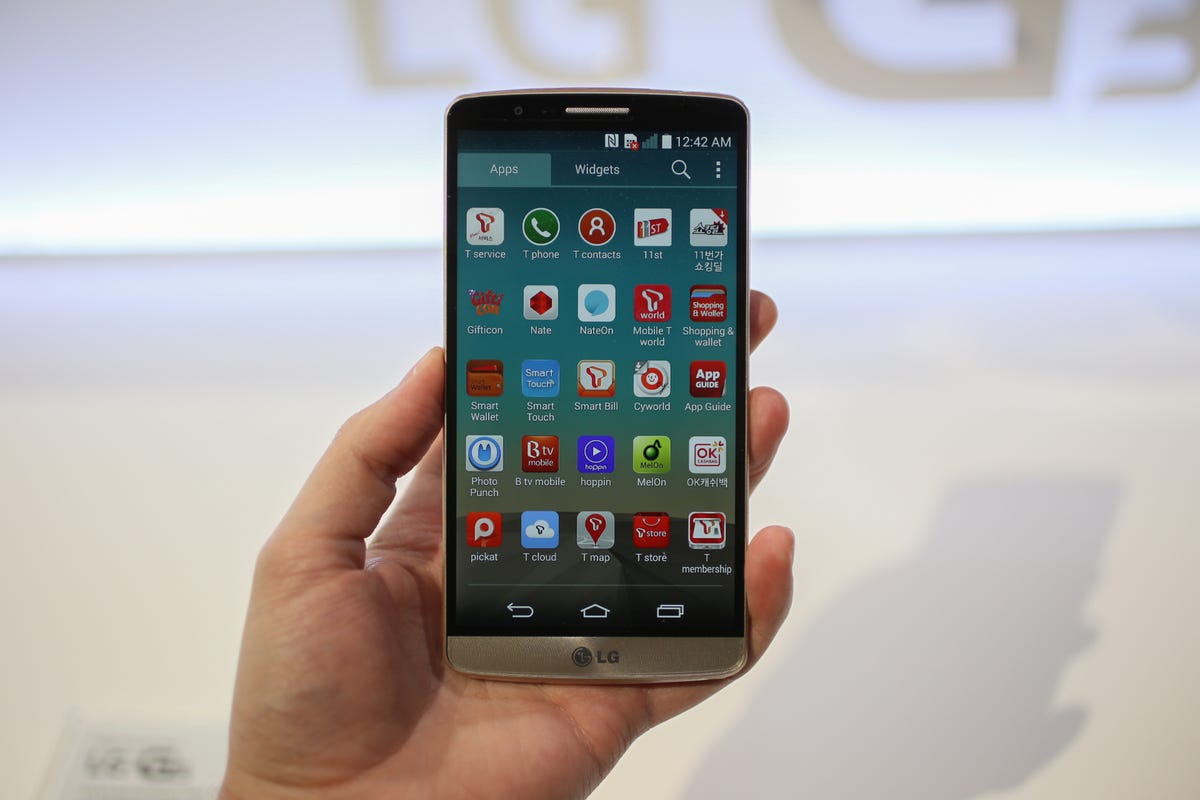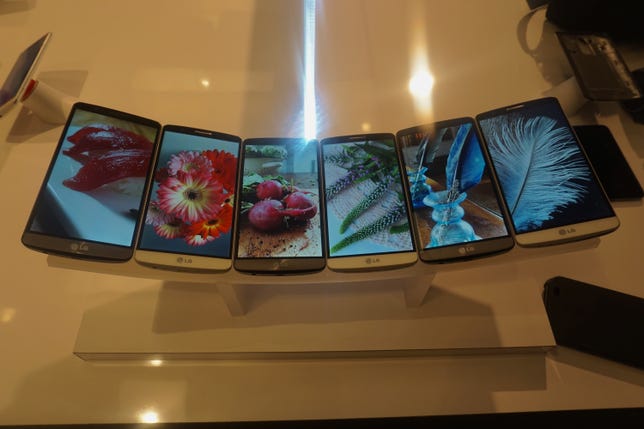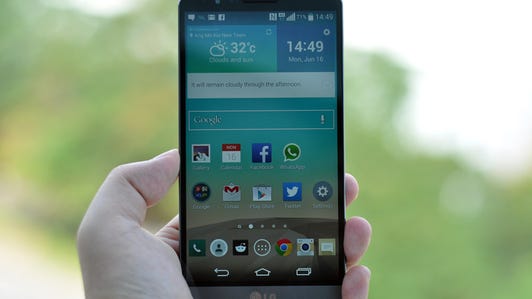
Nate Ralph/CNET
LG turned some heads on Tuesday with the debut of its eye-catching new G3 .
But in this game, a good — even great — smartphone simply isn’t enough.
It’s the sad reality that unless you’re Apple or Samsung, it is extremely tough to make a dent in the high-end smartphone market. That’s especially true in the US, where consumers have largely coalesced behind the iPhone and Galaxy S juggernauts.
LG is the latest big-name company to attempt the feat, following other major players such as HTC and Sony. Having a successful smartphone is particularly important for LG, which sees mobile as a critical front in a multi-pronged war in the consumer electronics business, with battles as varied as refrigerators and televisions. Having long lived in the shadow of the similarly diverse Samsung, LG believes it has its chance in the spotlight with the G3.
Related stories
- LG G3 goes for Samsung’s jugular with 5.5-inch display, laser-focused camera
- How the LG G2 looked to ‘Gangnam Style’ for inspiration
- Inside G Flex: LG’s long, winding road to setting the curve
- LG beats expectations with strong TV sales in Q1
- How LG’s laser focus created the G3 super smartphone (Q&A)
LG’s reason for its confidence in the US: a “double impact” that includes more aggressive marketing and a quietly building base of supporters more receptive to its products.
To the first, a stronger campaign that spells out the benefits of its new smartphone would do much to raise the profile of LG, which is more recognizable as a manufacturer of flat-panel televisions.
“There’s going to be aggressive marketing support around G3,” said Chang Ma, the head of mobile marketing in the US, in an interview. He teased a “significantly larger” budget than in years past.
As for the second, it remains unclear whether the groundswell of support that LG says in place will help propel sales and crucial word-of-mouth buzz. The previous flagship smartphone, the G2, was a solid device, and it has built up a decent amount of goodwill with its Nexus 4 and Nexus 5 smartphones, built in cooperation with Google. The curvy G Flex, while not a hot seller, at least demonstrated a willingness to innovate.
Globally, LG has made strides, tying with Huawei for third in global smartphone market share last year, according to Gartner. It stands alone as third in the US.
But its rank belies its true position. While LG holds nearly 5 percent of the market, nearly one in three smartphones sold around the world are made by its rival Samsung.
And while LG can claim moderate successes in both the G2 and the Nexus 5 smartphones, its mobile division had a mixed start to the year. It recorded an operating loss of 8.8 billion won ($8.6 million) in the first quarter, compared with a 132 billion won gain from a year ago. It shipped 12.3 million smartphones in the period, up 19 percent from a year ago, but down 7 percent from the fourth quarter.
LG hopes the G3 will get sales moving in the right direction again.
A simple message
The overall theme of the marketing campaign, mentioned many times over at the launch event, is the simplicity of the phone.
“We believe that we should not live a technology-driven life,” Ma said. “Technology is supposed to help you live your life.”
At the event, LG talked up some of the key benefits, including a crystal-clear display, faster camera focusing via laser technology, and more prescient notifications. The improvements are based on practical uses, as opposed to technology for technology’s sake, which Ma said the company wanted to avoid.


Nate Ralph/CNET
Even the user interface, which was a key complaint with the G2, has been stripped down.
“It’s much simpler and less ‘in your face,'” said Ramchan Woo, the head of LG’s mobile platform planning division, in an interview. “It’s definitely more subtle.”
The campaign will revolve around the idea of the phone improving your life, according to Frank Lee, a marketing brand manager for LG, adding that he sees the idea of a personal concierge as an important one for the G3.
It’s a fine line to walk. Even as the executives at the event espoused the benefits of simplicity, they couldn’t help but talk about the specifications, whether it was the number of pixels per inch on its new display (a staggeringly high 538ppi) or its laser-focusing camera.
“The fact that they were so focused on specs belies the simplicity message,” said Avi Greengart, an analyst at Current Analysis.
Bringing balance
The G2 was the first LG smartphone to launch on every major US carrier, and the G3 will do it again, with each of the carriers offering their support — even if none of them provided a firm launch date. The new phone will be less widely available in the UK, and Australian carriers will be announced nearer to its July launch date there.
LG believes that by going after a multi-carrier approach, it can more effectively market the product with a campaign tailored for the company. Gone are the days where companies were beholden to carrier support for advertising.
Ma said the campaign would be centered on LG, but that he would explore opportunities with the carriers as well.
LG G3 shows off high-res screen, metallic back (pictures)






Part of the challenge has been getting consumers to give smartphones beyond the iPhone 5S and Galaxy S5 a shot, which Ma conceded was a challenge. But he added that the G2 helped buy the company some credibility.
“The G2 did raise their profile a bit, even if it’s not quite where they want to be,” said Ross Rubin, an analyst at Reticule Research.
The carriers, meanwhile, acknowledge that the US market is skewed heavily towards two smartphones, and recognize it isn’t a healthy situation for the industry.
“They see us as a strong contender to bring balance,” Lee said.
Neither Ma nor Lee would specifically comment on the planned campaign in the US, but Lee teased “unconventional and disruptive” promotions around the launch.
Plenty of companies have shot for that third slot, whether it’s HTC with its recent One M8 , or even BlackBerry from last year. None have really made a lasting impression yet, although it’s still early for HTC.
LG united
Ma candidly admitted that LG’s brand — particularly with smartphones — wasn’t strong, and that consumers don’t yet have a good idea of the company’s identity. That remains a problem for the company.
“What is LG? People need to feel comfortable with the brand,” Greengart said.


Nate Ralph/CNET
LG is attempting to build out its name on the mobile end through its tablet line as well as the G Watch, its first smartwatch running Google’s Android Wear wearable-centric software. The company would be better served by leaning on its significant brand recognition in TVs and appliances as well.
Samsung has been able to smartly utilize its brand across different products through savvy marketing. Sony is attempting to rally its disparate units now.
For years, efforts by LG were complicated by the different consumer demographics its various units were targeting, Ma said. But he teased a more concerted effort to bring a unified marketing effort around LG products.
“The G3 is one of the first products where we’ll probably start talking about convergence and brand linkage between business areas and mobile,” he said.


Now playing:
Watch this:
LG G3 has tons of pixels and a laser, too
1:50



